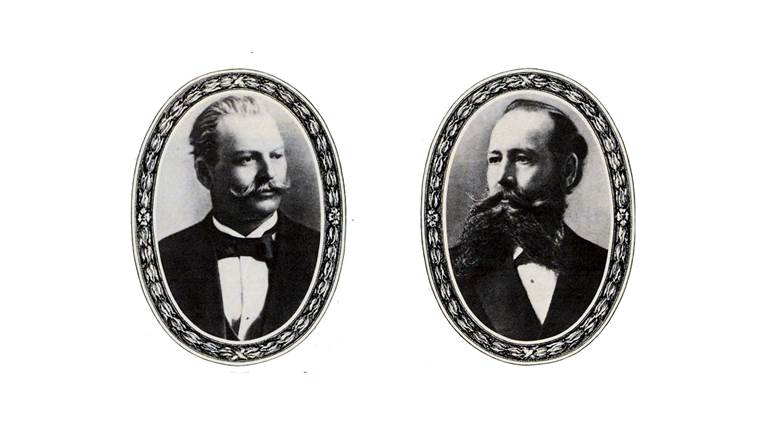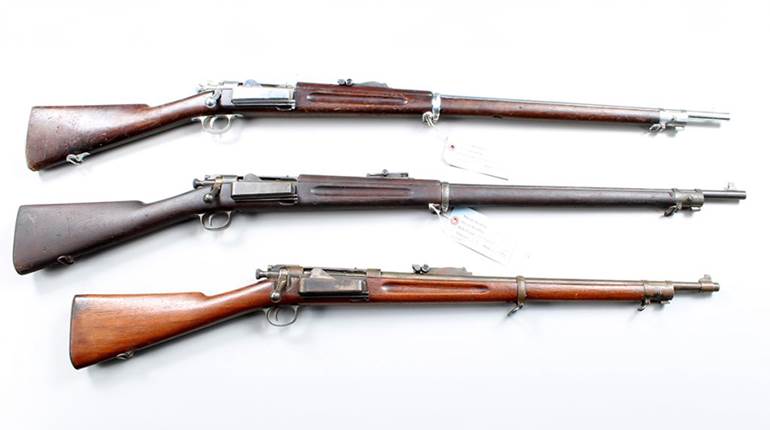
Revolution was brewing in Cuba during early 1898. The Cuban people sought their freedom from oppressive Spanish rule. Certain American “expansionists” saw opportunity in the midst of the ongoing fighting in Cuba. Reluctantly, President William McKinley prepared for a war to protect tenuous American interests in the Caribbean.
A fanciful interpretation of the Rough Riders in Cuba. While their ranks including many great horsemen, their actions in combat were fought on foot.
The battleship U.S.S. Maine was sent to Havana harbor to protect American citizens in Cuba, to show the flag and demonstrate the potential of American firepower. On the evening of Feb. 15, 1898, a massive explosion rocked the Maine. She sunk immediately in Havana harbor, her crew suffering terrible casualties--258 of the Maine’s 375-man crew were killed. More than a century later, no clear determination has been made if the explosion that destroyed the Maine came from an internal accident or from the actions of an outside saboteur.
The U.S. Army grew quickly in 1898 as volunteers (like these men of the 1st Illinois) arrived in great numbers. As there were not Krag rifles to equip them all, many units went to war with the venerable Trapdoor Springfield rifle, firing .45-70 Gov’t blackpowder cartridges.
In America, the general public was outraged. Folks in the East were spurred on by intensive newspaper coverage from the New York Journal (owned by William Randolph Hearst) and the New York World, (owned by Joseph Pulitzer). The agenda-driven reporting would come to be called “yellow journalism.” Apparently, “fake news” is not a modern idea. Newspapers stretched and distorted the truth, and at times outright lied about what was happening in Cuba. Regardless of their influences, the American public demanded action. On April 21, 1898, President McKinley sent an ultimatum to Spain that the nation withdraw its forces from Cuba. On April 25, Congress declared that a state of war existed between the United States and Spain.
While the U.S. Navy was up to the task, the Army wasn’t prepared for war. However, between the mobilization of National Guard units, and the sudden influx of volunteers, the ranks of the U.S. Army grew by more than 220,000 men. By June 22, American troops were landing just east of Santiago, Cuba.
Men of this Nebraska National Guard unit are equipped with both the modern .30-40 Krag–Jørgensen rifle and the venerable .45-70 Gov’t Springfield "Trapdoor" rifle.
Combat in Cuba and Puerto Rico was a strange combination of the old and the new. Initial U.S. Army movements were little more than recycled tactics from the American Civil War. On the other side of the line, the Spanish troops were seasoned by fighting Cuban guerrillas. They also were equipped with modern 7x57 mm Model 1893 Spanish Mauser rifles, charger-fed and firing smokeless-powder ammunition. But the Spaniards nullified some of their rifle-firepower advantage with a strange tendency to volley fire.

Troops volley-fire the Krag–Jørgensen rifle. Despite the increase in rate of fire with the advent of bolt-action rifles, many commanders of the era still relied on volley fire.
After learning some hard lessons early on, American troops adapted to the realities of a war for the next century. The Americans pressed forward, and the Spaniards grudgingly gave ground. Battles raged at Las Guasimas, El Caney, San Juan Hill and Fort Canosa in Cuba. In Puerto Rico, the bullets were flying at Yauco, Fajardo and San Germán.

Rebels engage Spanish troops with a wide range of rifles, including a Model 1885 Remington-Lee rifle (foreground), a Spanish Model 1893 Mauser (middle) and Remington Rolling Block rifles (background).
Troopers pose with their .30-40 Krag Carbines. Note also the M1892 Colt New Model Army Revolver, chambered in .38 Long Colt.
Foreshadowing global confliction to come, the Spanish-American War was far-flung, and fought on two widely-spaced island fronts: the Caribbean and the Philippines. At the time, the U.S. Navy’s great victories at Santiago de Cuba, and at Manila Bay, captured most of the headlines. But as always, it took the riflemen of the Army and Marines to secure the territory in question.
An efficient modification of the Krag rifle for cavalry use. Original examples of this handy carbine are highly-prized on the collector market.
The standard American long-arm for Marines and regular Army troops was the Krag–Jørgensen bolt-action rifle, chambered in .30 Army (.30-40 Krag). The Volunteer Cavalry (the Rough Riders) carried the Krag carbine. Both used smokeless cartridges.
The Norwegian-designed Krag–Jørgensen rifle was adopted in 1892, and production began at Springfield Armory in 1894, and continued until 1904.
The Krag–Jørgensen was a good rifle, but never a great one, at least not by American standards. The Krag served U.S. forces as a standard arm for just nine years. In that time the Krag was used in the war with Spain, the following actions of the Philippine Insurrection, and in the Boxer Rebellion during the multi-national Peking Expedition. During World War I the Krag rifles reemerged for training, but were never used in combat.
Details on the American Krag–Jørgensen rifle, the Springfield Model 1896.
The elegant lines of the Krag–Jørgensen rifle, the first bolt-action rifle adopted for general issue by the U.S. military.
As National Guard units were rushed into service, there were often not enough Krag–Jørgensen rifles to equip them. In these cases, troops were issued variants of the single-shot Model 1873 Springfield “Trapdoor” rifle. Slowly firing blackpowder cartridges and emitting massive clouds of smoke, the troops using Trapdoors were at a distinct disadvantage against opponents with the modern 7 mm “Spanish Hornet.” American marksmanship, coupled with traditional American heroism, ultimately proved to be the difference.
American troops in the Philippines: building the international reputation of the American rifleman.
During the Philippine Insurrection, a year after the Spanish-American War, men of the 20th Kansas were equipped with the Trapdoor Springfield rifle during the fighting on Luzon. When Gen. MacArthur asked how long the boys from Kansas could hold a critical position on the line, Col. Frederick Funston responded “Until the regiment is mustered out, General!” Archaic or not, the Springfield Trapdoor would could make a Moro rebel just as dead as any modern bolt-action rifle. American riflemen proved it time and again.
Men of Colonel Frederick Funston’s 20th Kansas equipped with Springfield Trapdoor rifles, ready to defend their trench line “until their regiment is mustered out.”
Rapid fire arms proved their worth during the Spanish-American War. The invasion of Guantanamo Bay saw the first American use of a machine gun in combat. When the Marines landed at Guantanamo, they brought along four Model 1895 Colt-Browning machine guns, chambered in 6 mm Lee Navy. Roosevelt’s “Rough Riders” had a pair of Model 1895s as well (privately purchased, these guns were chambered in 7x57mm Mauser). Lieutenant-Colonel Roosevelt was less than enthusiastic about his unit’s Model 1895 guns, calling them “more delicate than the Gatlings” and also “very readily out of order.” Even so, America’s early machine guns made their mark on the enemy.
So too did the venerable Gatling gun. Four of the Colt Model 1895 10-barrel Gatling guns (chambered in .30 Army), fired more than 18,000 rounds in less than nine minutes in support of the attacks on San Juan and Kettle hills. The value of suppressing fire was discovered that day.
A 10-barrel Model 1895 Gatling (.30 Army) at work in the Philippines.
Lieutenant-Colonel Roosevelt made the following remarks about the use of Gatling Guns that day in the book A History of the Gatling Gun Detachment, Fifth Army Corps, at Santiago (1898, Hudson-Kimberly Publishing):
“On the morning of July 1st, the dismounted cavalry, including my regiment, stormed Kettle Hill, driving the Spaniards from their trenches. After taking the crest, I made the men under me turn and begin volley-firing at the San Juan Blockhouse and entrenchments against which Hawkins' and Kent's Infantry were advancing. While thus firing, there suddenly smote on our ears a peculiar drumming sound. One or two of the men cried out, ‘The Spanish machine guns!’' but, after listening a moment, I leaped to my feet and called, ‘It's the Gatlings, men! It's our Gatlings!’ Immediately the troopers began to cheer lustily, for the sound was most inspiring. Whenever the drumming stopped, it was only to open again a little nearer the front. Our artillery, using blackpowder, had not been able to stand within range of the Spanish rifles, but it was perfectly evident that the Gatlings were troubled by no such consideration, for they were advancing all the while.”
Lt. John H. Parker’s battery of Gatling Guns provided highly effective suppressing fire on Spanish positions on Kettle and San Juan hills, allowing U.S. infantry and dismounted cavalry to take them.
Roosevelt went on to say: “From thence on, Parker's Gatlings were our inseparable companions throughout the siege. They were right up at the front. When we dug our trenches, he took off the wheels of his guns and put them in the trenches. His men and ours slept in the same bomb-proofs and shared with one another whenever either side got a supply of beans or coffee and sugar. At no hour of the day or night was Parker anywhere but where we wished him to be, in the event of an attack. If a troop of my regiment was sent off to guard some road or some break in the lines, we were almost certain to get Parker to send a Gatling along, and, whether the change was made by day or by night, the Gatling went.”
When the Spanish-American War was over, 281 American troops had been killed in action, and more than 1,500 wounded. More than 2,000 died from tropical diseases. Another 6,000 would die in the continuing violence in the Philippines during the Insurrection that lasted until 1902. Foreshadowing another long U.S. intervention in a far-off tropical land, the Moro Rebellion in the Philippines would last from 1899 until 1913.
To end the war, Spain gave up its claim to Cuba, and ceded Puerto Rico, Guam and the Philippines to the United States for $20 million. Spanish pride was crushed, its days of empire a distant memory, and the nation fell into a long period of decline.
Bankston Johnson, a Choctaw Indian, poses with a M1896 Krag “saddle-ring” carbine.
Back home, returning troops spent 30 days in mandatory quarantine due to their exposure to virulent tropical diseases. Roosevelt, who had formed and led the famed 1st Volunteer Cavalry (the “Rough Riders”), became a national hero. He took office as vice president in March, 1901, and with McKinley assassinated in September, he became president. He was elected to a full term in 1904 and served with distinction.
Splendid or not, the conflict with Spain had been quite some little war. America was reluctantly becoming a player on the world stage. Maturity as a superpower was soon to come.






































